Japan and the Meiji Revolution
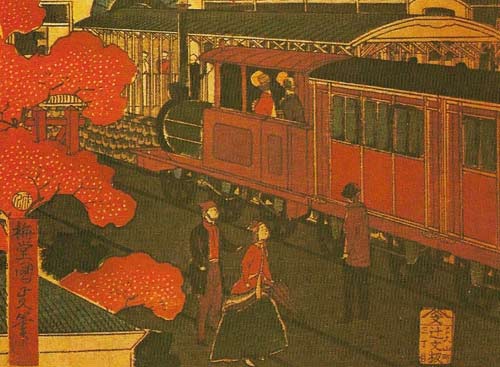
Figure 1. The first Japanese railway line, completed in 1872, was built by British engineers and covered the 29 kilometers (18 miles) between the capital, Tokyo, and Yokohama. Railways played a particularly important role in the modernisation of Japan for in pre-Meiji days there was very little wheeled traffic along the roads. Commerce between the main centers of the county was mainly seaborne. The growth of the railway system in 32 years was rapid: in 1886 there were 692 km (430 miles) of track; in 1896, 4,007 kilometers (2,490 miles) and in 1906, 8,494 kilometers (5,278 miles). By 1918 the total was more than 14,480 kilometers (9,000 miles) of working track.
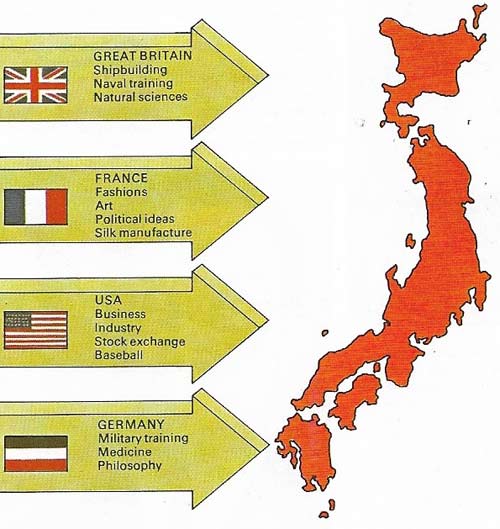
Figure 2. The greatest contribution to Japan's modernisation were made by Great Britain, the USA, Germany, France, Russia, and Italy. Britain trained the Japanese navy and influenced other maritime activities. The USA influenced such areas as business and education. France and Germany trained the army; Russia and Italy influenced the arts.
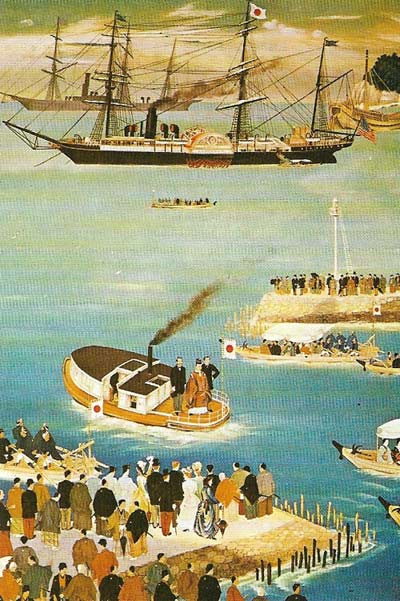
Figure 3. Japan's first important diplomatic mission abroad in 1871 was led by Prince Iwakura. In the United States and Europe the aim of the mission was to persuade the Western powers to revise the "unequal treaties" they had signed with Japan. But the Japanese had to wait nearly 30 years before they could secure treaty revision and thereby obtain tariff autonomy and the abolition of extraterritorial privileges. This picture of Iwakura's departure to Yokohama illustrates Japanese society obviously in a state of transition. Some of the men are wearing Western suits, while their companions still favor the traditional "top-knot" hairstyle and carry the samurai (warrior) sword.
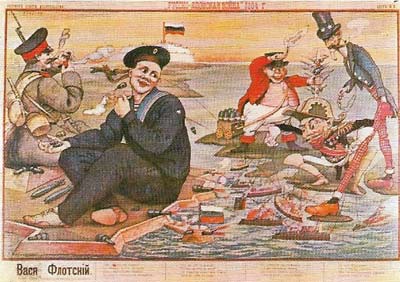
Figure 4. Japanese aggression against Russia and Japan's reliance on foreign military aid was ridiculed in this Russian cartoon of 1904. Although Britain supported Japan, diplomatically and with arms, the United States was not in fact directly involved and in the following year President Roosevelt (1858–1919) acted as mediator between the two belligerents. Despite the confidence of the Russian defenders in this picture, their fleet was destroyed in May 1905.

Figure 5. The death of the Emperor Meiji in 1912 marked the end of Japan's "Victorian age". The funeral procession in Tokyo took place at night, the coffin being carried on an ox-wagon from the palace to Tokyo Station. Enormous silent crowds kneeled respectfully as it passed. Interment was at Momoyama near Kyoto. A detachment of Royal Marines took part in the funeral procession.
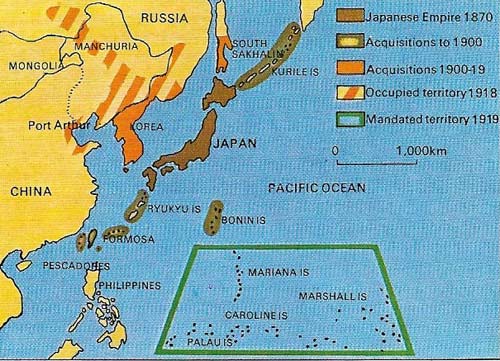
Figure 6. The expansion of Japanese territory at the end of the 19th and early part of the 20th century was a result of both war and treaties. In 1875 the Kurile islands were acquired from Russia by treaty in exchange for abandonment of Japanese claims on Sakhalin. Formosa was won in the Sino-Japanese War; south Sakhalin, lease of Port Arthur and rights in south Manchuria in the Russo-Japanese War. Korea was annexed in 1910.
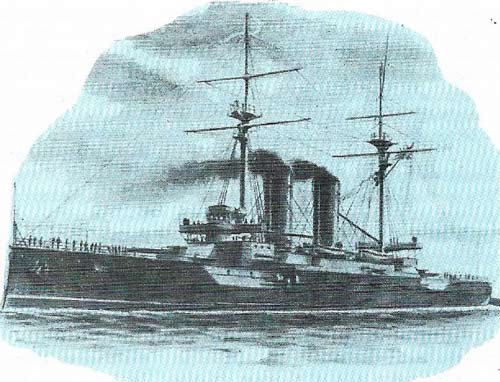
Figure 7. The Japanese battleship Kashima (16,660 tons; four 12-inch guns) was built by Elswick shipyard and launched at Newcastle in 1905. Until the Russo-Japanese War all Japan's larger warships were built abroad, the majority of them in Britain. The last was the battle-cruiser Kongo (27,500 tons; eight 14-inch guns) launched by Vickers Armstrong, Barrow-in-Furness, in 1913.
Until the middle of the 19th century Japan had been closed to the outside world for more than 200 years. Only the Chinese and the Dutch were allowed limited trading access to one port, Nagasaki. It was Commodore Matthew Perry in command of a squadron of United States warships who, during visits in 1853 and 1854, cajoled a reluctant shogunate – Japan's military government – into opening two ports to American shipping. Other powers soon followed the American lead; within a few years Japan's self-imposed seclusion was over.
Civil war and a new capital
The intrusion into Japan by the Western world mortally harmed the prestige of the Tokugawa shogunate which, under pressure, signed treaties granting extraterritorial rights and tariff privileges to the foreign powers (Figure 3). The imperial court at Kyoto, universally revered but possessing no effective power of its own, became the focus of loyalty for those samurai (warriors) who called for the expulsion of the alien "barbarians". After some years of complicated domestic strife the shogunate was overthrown in 1868 by an alliance of provincial lords and warriors from domains in southwest Japan. Their successful civil war was fought in the name of the youthful 'Emperor Meiji – "enlightened rule". He was installed in the shogun's castle at Yedo which was renamed Tokyo and made the new capital.
By this political upheaval, known as the Meiji Restoration, governing powers were restored, although in name only, to the imperial house. It marked the beginning of Japan's transformation from a feudal society to a modern state. The new government, an oligarchy of relatively young samurai, resolved to bring Japan up to the technological level of Europe and the United States.
Japan's industrial revolution
Foreign teachers and specialists of every kind, skilled in the techniques of Western civilization, were invited to Japan; and Japanese in large numbers went abroad to study (Figure 2). Remarkable progress in modernization was made within two decades (Figure 1). The cotton-spinning industry provides a striking example. In the 1870s annual production, increasing yearly, barely exceeded 2,000 bales, but the figure for 1889 was 142,000 bales; ten years later it was 750,000 bales. Comparable growth occurred in many other sectors of manufacturing industry. Almost none of this early expansion was financed by borrowing abroad – instead the cost fell heavily on the rural areas.
Japan's industrial revolution was broadly completed by the eve of World War I and within the lifetime of some of the leading figures of the Meiji Restoration. Political change was symbolized by the Constitution of 1889 which established a diet (parliament) of two chambers. But the Meiji Constitution was authoritarian in letter and spirit. The upper house of the diet was non-elected and until after World War I members of the lower house were elected on a limited suffrage. Cabinet ministers were responsible only to the emperor, not the diet, and the war and navy ministers were always generals and admirals representing services strongly imbued with the samurai martial spirit.
The same spirit was also perceptible among the people at large for the state education system gave great importance to loyalty and patriotism. The effectiveness of such indoctrination was illustrated by the events of the Sino-Japanese War of 1894–1895 and the Russo–Japanese War of 1904–1905.
Military and naval supremacy
In both struggles the Japanese surprised the world with their victories on land and sea, of which the most dramatic was the destruction of the Russian fleet off Tsushima in May 1905 by Admiral Togo (1847–1934). This masterly demonstration of naval supremacy won Japan acceptance as a great power.
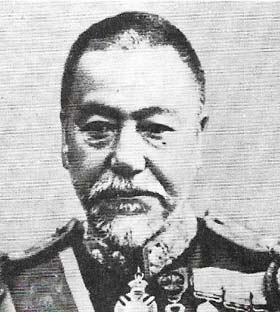 |
| Admiral Togo Heihachiro, a national hero after his annihilation of the Russian Baltic fleet at Tsushima in 1905, was revered almost as much in Britain as in Japan. Trained in England in HMS Worcester, he based his signal at Tsushima – "On this battle will depend the fate of our empire" – on Nelson's famous signal at Trafalgar exactly one century earlier. He was created count in 1907 and dies in 1934, aged 87. |
The Sino-Japanese War had arisen from rivalries in Korea. Japan's victory gave her possession of Formosa and eliminated Chinese influence in Korea. In 1904 the reason for war was again largely Korea. Russia, occupying key points in Manchuria, seemed about to penetrate Korea, still nominally an independent state, although then dominated economically and politically by Japan. By the Treaty of Portsmouth (New Hampshire). in the United States, which ended the Russo-Japanese War, Japan acquired south Sakhalin and inherited Russia's lease of Port Arthur and her valuable rights and interests in south Manchuria. This setback for Russian power in the Far East sealed the fate of Korea, which was finally annexed by Japan in 1910 (Figure 6).
Emperor Meiji died in 1912 (Figure 5). Due to ill health the new ruler (Taisho) was a mere figurehead. The Anglo-Japanese Alliance, first concluded in 1902 as a gesture of solidarity against Russian ambitions in Asia, brought Japan into. World War I on the British side. Japanese forces captured Germany's leased port in China, Tsingtao, and occupied her island possessions in the Pacific. While the European powers fought each other, Japan partly extended its influence over a weak and divided China.
At the 1919 Paris Peace Conference, Japan was given a permanent seat on the Council of the newly created League of Nations, which amounted to full recognition of Japan's status as a world power. In the space of 50 years the aims of the early Meiji modernizers had been achieved.
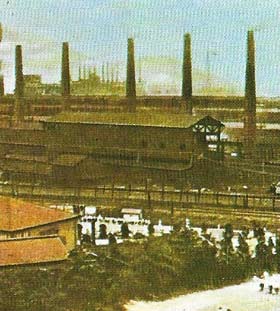 |
| The Yawata Ironworks in northern Kyushu (completed in 1901) was for many years the main steel-producing plant in Japan. Production of iron and steel on a large scale began relatively late because Japan was deficient in natural resources such as iron ore and coking coal. The need for these materials, essential to Japan's industrialisation, was one of the reasons for Japan's aggressive interest in both Manchuria and China. |
